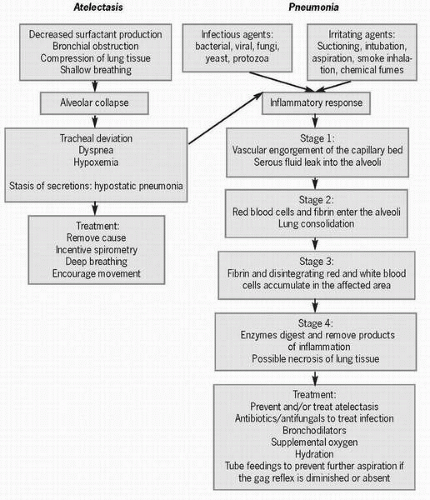Pneumonia and Atelectasis
This chapter discusses the pathophysiology associated with two common causes of impaired gas exchange, pneumonia and atelectasis. Pneumonia is an inflammatory process that may be caused by numerous infectious agents. It is the sixth leading cause of death in the United States and the leading cause of death from infection. Atelectasis, or incomplete alveolar expansion or collapse, occurs when the walls of the alveoli stick together.
Pneumonia, the sixth leading cause of death in the United States and the leading cause of death from infection, is an inflammatory process that may be caused by numerous infectious agents, such as bacteria, viruses, fungi, yeast, or protozoa. Streptococcus pneumoniae, a bacterium, is responsible for up to 75% of all cases of pneumonia. In contrast to bacterial pneumonia, viral pneumonia is usually mild and heals without intervention; however, it can lead to a more virulent bacterial pneumonia.
 Pneumonia is an inflammatory process that may be caused by numerous infectious agents.
Pneumonia is an inflammatory process that may be caused by numerous infectious agents.Irritating agents or events, such as suctioning, intubation, aspiration of gastric juice, inhalation of smoke, or chemical fumes, can also lead to pneumonia. Aspiration pneumonia may occur because the gag reflex is impaired as the result of a brain attack or because a nasogastric tube prevents the lower esophageal sphincter from closing, allowing gastric juice or tube-feeding formula to enter the lungs. Gastric secretions and tube-feeding formulas are irritating to lung tissue and set up an inflammatory response when aspirated.
 Irritating agents or events, such as suctioning, intubation, aspiration of gastric juice, inhalation of smoke, or chemical fumes, can also lead to pneumonia.
Irritating agents or events, such as suctioning, intubation, aspiration of gastric juice, inhalation of smoke, or chemical fumes, can also lead to pneumonia.Other common causes of pneumonia are stasis of respiratory secretions and thickened secretions. Stasis of secretions in immobile patients can lead to pneumonia because bacteria can grow in the static secretions. When respiratory secretions become thick, as in a patient with fluid volume deficit, ciliary action cannot remove the bacteria-laden mucus, and pneumonia may result.
Stay updated, free articles. Join our Telegram channel

Full access? Get Clinical Tree



